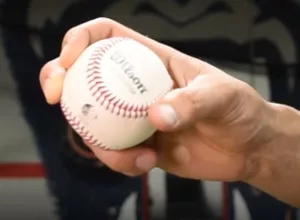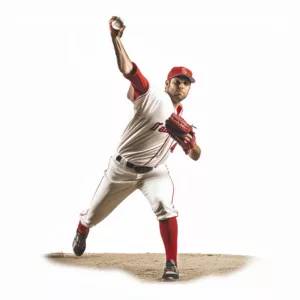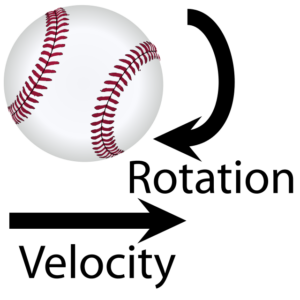If you are looking for a guide on How to Throw a Curveball then you landed it!
Baseball, known as America's pastime, is more than simply a game; it's a complicated blend of individual abilities, team plans, and physical prowess. The sport's attractiveness resides in its complicated nature, which requires both physical and mental agility from its players. Each player on the field has a certain job, and each role requires a unique set of specialized talents. Every aspect of the game, from hitting and fielding to running and pitching, needs precision, finesse, and a thorough understanding of the game's fundamentals.
Pitching is often a focal point among these diverse skill sets, a mesmerizing art form that has captivated viewers and players alike for decades. The curveball, a pitch that is as beautiful as it is deceptive, is proof of this. Its unexpected trajectory and quick break as it approaches the plate make it a valuable tool in a pitcher's arsenal. Throwing a curveball that stuns batters needs elegance, understanding, and consistent work. In the discussion that follows, we'll go into the physics behind this captivating pitch, as well as the technical components of its execution and tactics for refining and perfecting the art of throwing an exquisite curveball.
How to Throw a Curveball: A Brief Overview
A curveball is a baseball pitch in which the ball curves or breaks as it approaches the batter's plate. It's thrown with a unique grip and arm motion that imparts spin on the ball, making hitters' predictions difficult.
The diagram above depicts how the curveball fits into the many types of pitches and the critical components of it that will be discussed further.
Getting a Grip: The Initial Setup
 A vital step in throwing a great curveball is mastering the grip. The grip is what distinguishes the curveball from other pitches, influencing the spin and eventual direction of the ball. A pitcher begins to pour their personal finesse into the pitch at this point, generating the ideal conditions for a curveball that confounds batters and dazzles viewers.
A vital step in throwing a great curveball is mastering the grip. The grip is what distinguishes the curveball from other pitches, influencing the spin and eventual direction of the ball. A pitcher begins to pour their personal finesse into the pitch at this point, generating the ideal conditions for a curveball that confounds batters and dazzles viewers.
It is critical that your fingers are properly positioned on the ball. Unlike other pitches that require a firm grip along the seams, the curveball necessitates a strong grip across the broad seams. Here, your middle finger takes the lead, firmly positioned along one seam. It is vital in the pitch, controlling the spin of the ball upon release.
The position of your thumb is also significant in this grip setup. It should be placed beneath the opposite seam to provide balance and control. Meanwhile, your index finger, which plays a supportive role in this grip, can rest next to your middle finger or be slightly lifted, depending on your comfort and inclination. As small as these differences may appear, they have a significant impact on the final trajectory and break of your curveball.
The Release: Fine-Tuning the Delivery
 In a curveball pitch, the process of releasing the ball is analogous to the final stroke of a painter's brush that brings the masterpiece to life. It's a crucial stage of the pitch, bringing together grip, movement, and trajectory into a single, defining moment. Your release method will have a huge impact on the pitch's overall success, making the difference between an ordinary toss and a dazzling curveball.
In a curveball pitch, the process of releasing the ball is analogous to the final stroke of a painter's brush that brings the masterpiece to life. It's a crucial stage of the pitch, bringing together grip, movement, and trajectory into a single, defining moment. Your release method will have a huge impact on the pitch's overall success, making the difference between an ordinary toss and a dazzling curveball.
The position of your forearm becomes critical as you stride towards the release point. Pronating the forearm (turning the palm downwards) is a typical mistake; however, the curveball demands a supinated position (palm facing up). Maintaining this forearm position is critical because it helps generate the proper spin for a curveball, adding that deceptive element that confuses the batter.
The escape of the ball from your hand during the release is an art form in and of itself. The ball should feel as if it is rolling off your index finger last, providing the distinctive topspin that distinguishes a curveball. This spin causes the pitch to curve downward as it approaches the batter, providing a difficult-to-predict trajectory that causes batters to second-guess their swing. The successful curveball is the result of the correct grip, supinated forearm stance, and meticulous release.
Curveball Trajectory: Creating the Deceptive Movement
 The curveball gets its name and its captivating effect from its peculiar movement, which is the result of a particular topspin generated during the delivery. In contrast to the backspin of a fastball, this topspin causes an interesting physical phenomena that distinguishes the curveball. This movement adds a surprise element to the pitch, keeping hitters guessing and spectators on the edge of their seats.
The curveball gets its name and its captivating effect from its peculiar movement, which is the result of a particular topspin generated during the delivery. In contrast to the backspin of a fastball, this topspin causes an interesting physical phenomena that distinguishes the curveball. This movement adds a surprise element to the pitch, keeping hitters guessing and spectators on the edge of their seats.
The topspin produced by the tight grip and accurate release technique is at the heart of this peculiar movement. When the pitcher releases the ball, the position of the fingers imparts a forward spin, similar to spinning a wheel. This topspin is important because it interacts with the air resistance, resulting in a pressure differential above and below the ball. As the ball approaches home plate, the pressure differential causes it to break or curve downwards.
The resulting trajectory is what gives the curveball its distinct personality. Unlike a fastball, which moves relatively straight, or a slider, which breaks laterally, a curveball has a distinct downward curve. This abrupt change in trajectory, which occurs frequently late in the ball's flight, perplexes hitters, leaving them swinging at air or stopping in their tracks. In short, the curveball's creativity rests not only in its execution but also in the distinctive movement it produces, giving it a strong weapon in a pitcher's arsenal.
Training Drills for How to Throw a Curveball
Understanding the technique and repetition are required to develop an efficient curveball. Here are some drills to help you improve your curveball pitch:
- Wall Drill: Stand a few feet away from a wall and perform a wall drill. Experiment with the arm motion and release of the curveball pitch, aiming for the ball to contact the wall and drop straight down.
- Target Practice: Practice pitching from a small distance with a target or a partner. As your curveball improves, gradually increase the distance.
- Mirror Drill: Practice your curveball pitching motion in front of a mirror. This will assist you in self-analysis and technique correction.
Enhancing the Effectiveness of How to Throw a Curveball
The effectiveness of your curveball will largely depend on your delivery and consistency. Here are a few tips to enhance the potency of your curveball:
- Vary Speeds: By changing the speed of your curveball while maintaining the same arm motion, you can keep batters off-balance.
- Mix in Other Pitches: Throwing a curveball back-to-back with a fastball can make it challenging for the batter to adjust in time.
- Location: Practice pitching the curveball to different locations to become unpredictable to the batter.
Don't Stop With How to Throw a Curveball Advance all Your Pitches
 There is no greater companion in your quest to take your pitching skills to new heights than the TopVelocity Pitch Analytics course. It's not just about improving your curveball; it's about completely overhauling your pitching repertoire. So, why bother? Make the first step toward mastery today.
There is no greater companion in your quest to take your pitching skills to new heights than the TopVelocity Pitch Analytics course. It's not just about improving your curveball; it's about completely overhauling your pitching repertoire. So, why bother? Make the first step toward mastery today.
This course, created by industry specialists, employs cutting-edge analytics to dissect the subtleties of your pitch. Every aspect of your pitch is examined, from grip to release, trajectory to spin rate, and provides you with in-depth insights and practical feedback.
Empower yourself with information, and let TopVelocity be your lighthouse on the road to becoming an outstanding pitcher. Don't just aim to be better; seize the chance to be the best. You're not simply investing in a product when you take the TopVelocity Pitch Analytics course; you're investing in your future in the major leagues.
Join the ranks of renowned athletes who have used TopVelocity to transform their pitching abilities. Don't put off greatness. Purchase the TopVelocity Pitch Analytics course today and start your trip to the elite level!




